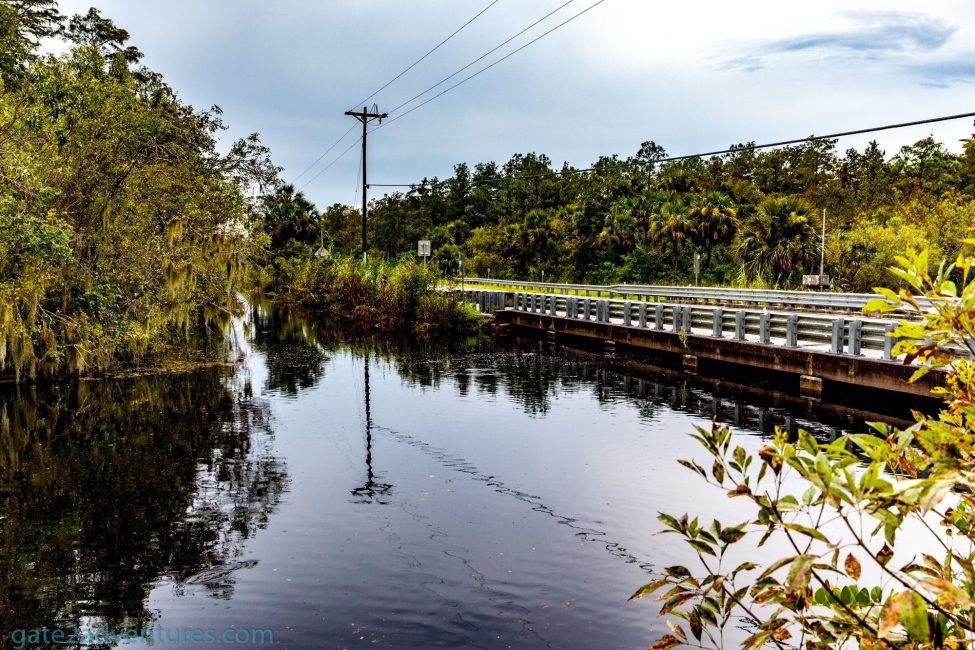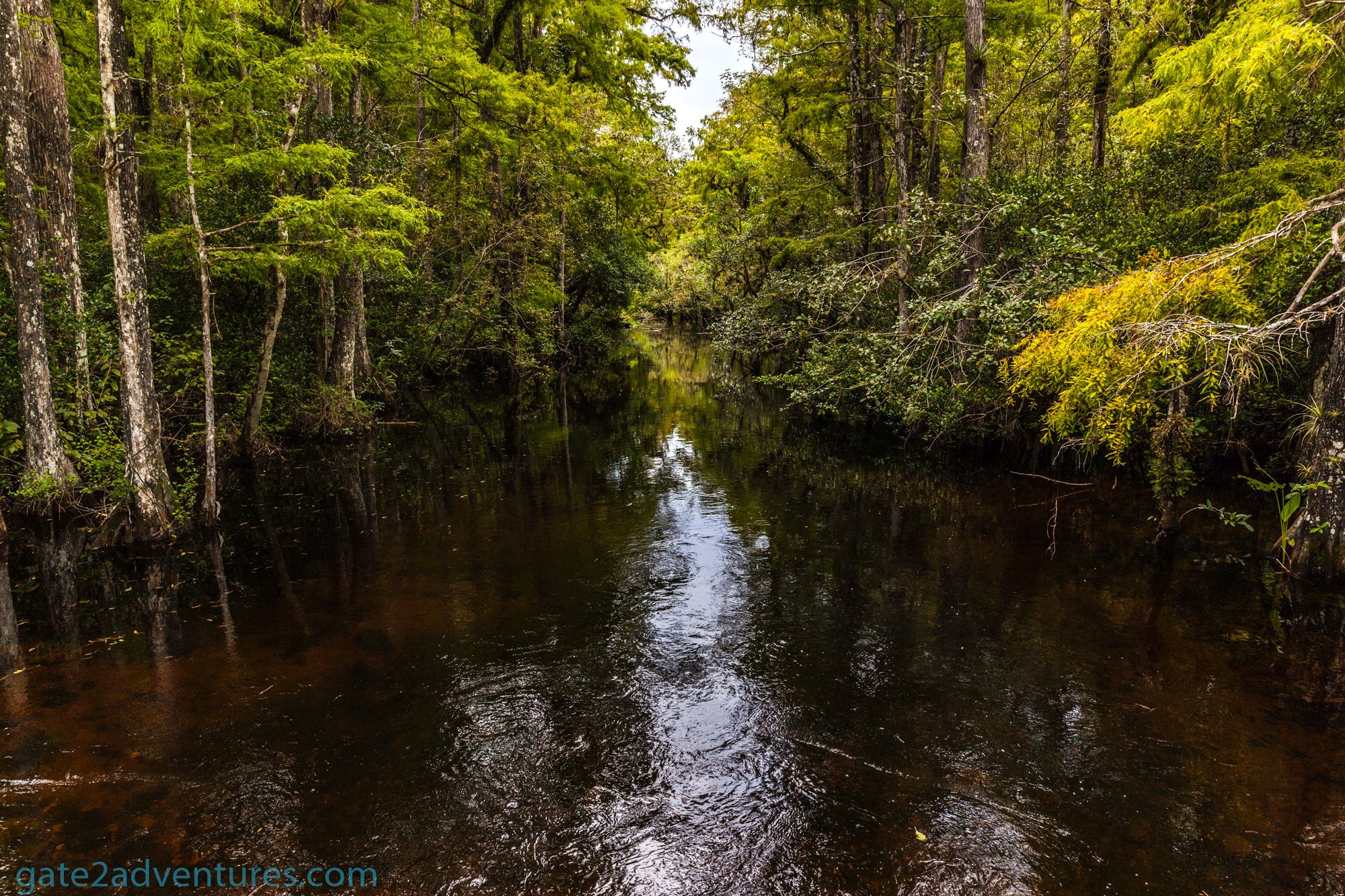The Tamiami Trail is the southernmost 275 miles (443 km) of U.S. Highway 41 (US 41) from Tampa to Miami. The name “Tamiami” is derived from the two cities it connects – Tampa and Miami. It was the first road to cross the Everglades and opened on April 26, 1928, after 13 years of construction. This portion of the road has also the hidden designation of State Road 90 (SR 90). It runs from east to west and forms part of the northern border of the Everglades National Park. The road becomes Southwest Eighth Street in Miami-Dade County, better known as “Calle Ocho” in Little Havana, which is a part of Miami. North of the road you have the Big Cypress National Preserve and to the south of it Everglades National Park. The biggest differences between the two are the regulations. As a national park is highly regulated and only allows limited outdoor and backcountry use, while the Preserve is open for backcountry use like off-roading.
This is a great alternative to the busy city-life of Miami and Miami Beach. Go on a road trip and enjoy nature in a way you can only find it in the Everglades. Take the Tamiami Trail and drive over to Marco Island, a place known for its beach resorts and golf clubs, or take it all the way to Naples.
Start your drive early as there is so much to see and do along the road through the Everglades and Big Cypress National Preserve. Here are a few of my favorite spots you should consider visiting as you drive East to West.
Airboat Tours
Airboat Tours are plentiful along the way. Which one you should visit is fully up to you. Most of them offer the same activities which are the airboat rides. Some of them have a restaurant while others only provide snacks. It is up to you, which one you should visit. Maybe you found a coupon for some savings at a specific place, then go for it. Some of the better knowns once are
It is probably the proximity to Miami which gives them a lot of visitors compared to the other once towards the west-end of the Everglades. These three offer discounts if you go to their website. Some in the form of a coupon or an advanced online reservation.
Be aware that there is a National Park Entrance Fee if you take any airboat rides to the south of Highway 41, which will actually take you into the Everglades National Park. At the moment the fee is $3 for persons over the age of 16. Children under 16, National Park System Pass Holders, active duty military, and seniors are free. If you plan to visit other destinations in the Everglades like Shark Valley Visitor Center or Flamingo Visitor Center, buy an annual pass. Shark Valley charges $25 per vehicle if you don’t have a pass. You have the option to buy an annual pass only for the Everglades ($40) or one for the whole National Park System ($80). I highly recommend buying the annual pass for $80 if you live in the United States and even for tourists it might be an advantage when they are traveling to other National Parks along their trip.
Wildlife Viewing and Roadside Parks
Wildlife viewing along the road is plentiful. You have chances to view wildlife and encounter different species at any of the listed spots below. Besides wildlife viewing, why not combine it with a picnic.
These parks below are great and might be worth a visit.
ValuJet 592 Memorial
 This is a memorial to remember ValuJet flight 592, which crashed into the Everglades on May 11, 1996. The flight was scheduled to fly from Miami to Atlanta but never made it past the Everglades. Everyone aboard died in this tragic accident.
This is a memorial to remember ValuJet flight 592, which crashed into the Everglades on May 11, 1996. The flight was scheduled to fly from Miami to Atlanta but never made it past the Everglades. Everyone aboard died in this tragic accident.
The memorial was commissioned on the third anniversary of this tragic plane crash. 110 concrete pillars, one for every person aboard, form a triangle that points towards the crash site about 8 miles from the memorial.
Today, the memorial almost got forgotten. Many people come here to fish but almost no one visits the memorial. The memorial is visible from the road if you know what you are looking for, but there are no signs.
Everglades National Park – Shark Valley

Shark Valley is one of two points of access to the Everglades National Park along the Tamiami Trail beside Everglades City. The visitor center offers educational displays, a park video, and informational brochures. Various souvenirs are available at the visitor centers gift shop.
From the visitor center, a 15-mile loop road extends south into the Everglades with a 45-foot tall observation tower at its southernmost point. The loop road is perfect for hiking and pedaling. If you don’t have a bike with you, you can rent one for $9/hour. With the bike, the round trip takes about 2-3 hours. Depending on how much time you spend at the observation tower and along the way. Alternatively, you can take a guided tram tour which lasts about 2 hours and makes a brief stop at the observation tower and multiple other points along the way to point out the unique features of the Everglades. For prices and tram tour hours visit the Shark Valley Tram Tours website.
I did rent a bike, rather than taking the tram tour. Be prepared that the weather can change quickly here, especially during the summer months. When I left the visitor center, there were blue skies with a few clouds. By the time I got back, a thunderstorm was ready to break loose and I caught some raindrops on my way back.
Also, bring plenty of water when you visit. Especially if you are hiking or biking. There is a chance to refill your bottles at the visitor center, but the water comes out warm and is regular tap water, so not very tasty. Restrooms are available at the visitor center and at the observation tower. I highly recommend using the restroom facilities at the visitor center as there are only porta-potties at the observation tower. The building next to the tower, which used to be the restroom facilities got damaged and is now closed.
Fees and Passes
Be aware there is a National Park Entrance Fee but you are in luck if you are a holder of an annual National Park Pass and the fee is waived. Your regular entrance fee is good for 7 days at any of the Everglades entrance points including the road to Flamingo.
Miccosukee Indian Village

Not far from the Shark Valley Visitor Center is the Miccosukee Indian Village. You will learn more about the tribe and its culture and heritage. Learn about their craft of from woodcarving to patchwork, beadwork, basket weaving to doll making. Haven an alligator encounter and watch the show. For an additional fee, you can have one of the Miccosukee Alligator Wrestler teach you how to respectfully touch and mount a large size Florida Alligator.
From the village, you can also take airboat rides and explore the Everglades in a unique way. Just a bit further down the Tamiami Trail towards the west, you can see the center of the Miccosukee Tribe with school and management facilities. You can’t miss it as you will see some of the tallest buildings in the Everglades including the water tower.
Clyde Butcher’s Big Cypress Gallery

Don’t just visit the swamps, walk the swamps. Clyde Butcher is known for his black and white photography of Florida’s wilderness. Take a tour into the swamp behind his gallery. Besides the 2-hour eco swamp tour, you can book an advanced 3-hour photography swamp walk. Your guide will point out the flora and fauna of the swamp. Get away from your busy life and enter the swamp for an unforgettable experience.
Learn more about the artist on his website.
Big Cypress Oasis Visitor Center

Before the building became a visitor center it was an eye-catching private airport with a hangar and restaurant. Eye-catching because of the Lockheed Constellation mounted on top of its roof.
The National Park Service purchased the building in the 1980s to be used as a visitor center. Inside are exhibits related to the natural and cultural history of the preserve and an introductory film. You can also find a bookstore and gift shop inside.

Outside is a boardwalk along the canal. It’s almost guaranteed to see alligators in this stretch of the canal. Every time I visited I saw some out there and got some amazing pictures. Unbelievable but I was able to witness how an alligator fed on another but a dead alligator. It is worth to stop here, even tho they charge a parking fee.
The visitor center is open every day (except December 25) from 9 a.m. – 4:30 p.m.
Skunk Ape Research Headquarters
 You wonder what a skunk ape is? Have you heard of Bigfoot? Well, the Skunk Ape is the smelly “Bigfoot” of the Everglades. The smell fo these creatures have been reported to be similar to rotten eggs or methane. Theories are that the creature lives in alligator dens filled with swamp gas and rotting animal cadavers. Dave Shealy is operating the Skunk Ape Headquarter along the Tamiami Trail. According to Dave Shealy, about 7-9 Skunk Apes live in the Florida Everglades.
You wonder what a skunk ape is? Have you heard of Bigfoot? Well, the Skunk Ape is the smelly “Bigfoot” of the Everglades. The smell fo these creatures have been reported to be similar to rotten eggs or methane. Theories are that the creature lives in alligator dens filled with swamp gas and rotting animal cadavers. Dave Shealy is operating the Skunk Ape Headquarter along the Tamiami Trail. According to Dave Shealy, about 7-9 Skunk Apes live in the Florida Everglades.
If you want to learn more about the Skunk Ape, stop by at the Skunk Ape Research Headquarter. Its filled with information about this elusive creature. Check out the gift shop for more Skunk Ape swag.
Joanie’s Blue Crab Cafe
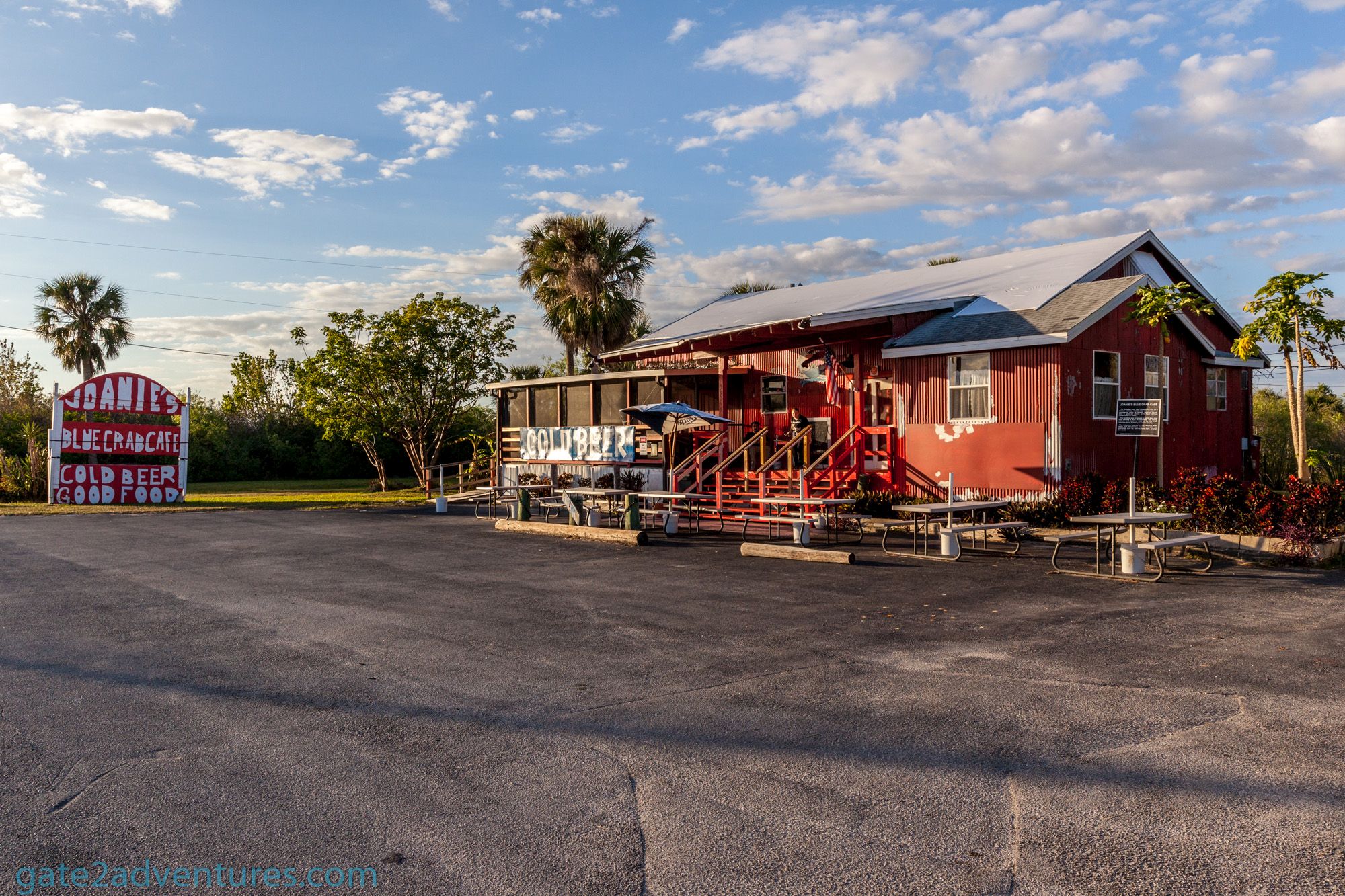
If all the driving made you hungry, stop at Joanie’s Blue Crab Cafe. The opening hours vary a lot. Check the cafe’s website first and if you want to go, make sure you call ahead to make sure the place is open, as it could close early.
Phone Number: 239-695-2682
The building is near the Ochopee Post Office and you can’t miss it. Even if you are just traveling through the area, it’s a great spot at least to snap a picture.
Ochopee Post Office: Smallest Post Office in the United States

The Ochopee Post Office is the smallest post office in the U.S. and is still being used as such with just 61 square feet. It serves the surrounding populations of Miccosukee and Seminole Indians. The once irrigation pipe shed became the town’s official post office in 1953 after a fire burned down the nearby general store, which also dubbed as the post office.
The postmark of the Ochopee Post office is famous under collectors with the zip code 34141. Drop me a message and I can help you by sending a postcard or envelope.
Even one of the strongest hurricanes ever recorded, Hurricane Irma, was no match for the smallest post office in the nation as it went through Southwest Florida on September 10, 2017.
Hours of operation are 8 a.m. to 10 a.m. and noon to 4 p.m. Mondays through Fridays and 8 a.m. to noon Saturdays in case you want to visit and collect the postmark yourself.
Big Cypress Swamp Welcome Center
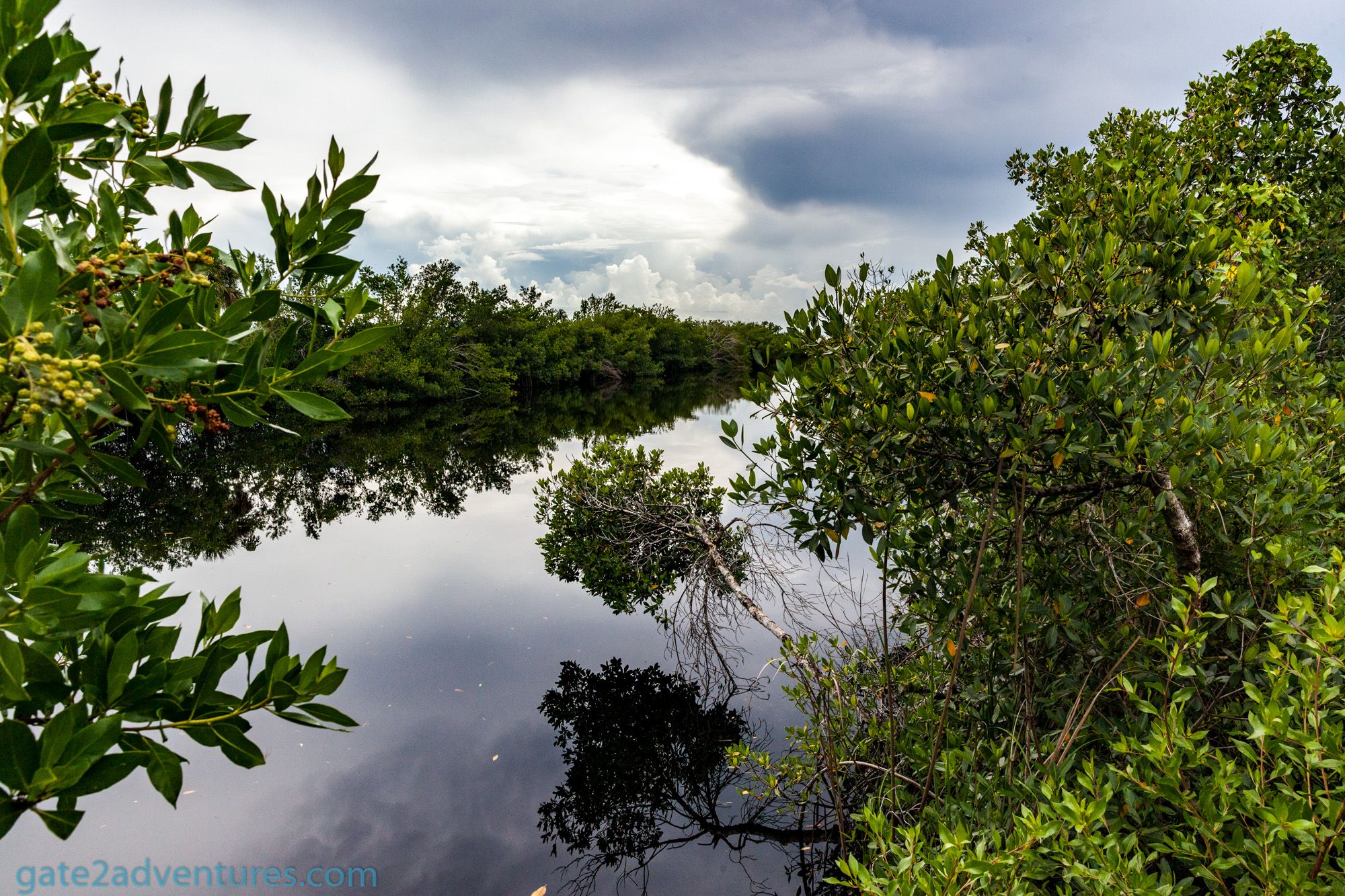
Coming from the west on the Tamiami Trail, this should be one of your first stops to get acquainted with the Big Cypress Swamp. Learn about the importance of water in the swamp and what it means for wildlife. See an old wooden canoe that was used to get around the swamps or check out the Swamp buggy exhibit outside the main building. The buggy is enclosed in a glass building. This makes it unfortunately hard to see and even harder to take pictures of with all the glare on the glass from the sunlight.

Out in the back of the visitor center is a short boardwalk trail along a mangrove canal. Use the chance for some wildlife viewing or just to relax. Take the short stroll all the way to the end and see the sea level rise marker. You can see what the water level is now and what the predictions are. You will be shocked.
The visitor center itself is open daily (except December 25) from 9:00 a.m. – 4:30 p.m. Outside the hours of operations you can visit the other exhibits outside of the visitor center and take a stroll along the boardwalk.
Everglades City and Chokoloskee Island

Everglades City is another way to enter the Everglades National Park beside Shark Valley along the Tamiami Trail. A temporary visitor contact station is in place until the visitor center is repaired, which got destroyed in September 2017 by hurricane Irma. Take a boat tour from here and explore the Ten Thousand Islands, a maze of mangrove islands and waterways that extends to Flamingo and Florida Bay. Boat tours run every day of the year. During repair of the visitor center, buy the tickets for the tour across the street, at the building next to the observation tower (905 S. Copeland Ave. Everglades City, FL 34139) or online.
While you here, check out the observation tower. The entrance fee is $2 in quarters. There is a dispenser available to give you change for paper bills. However, no credit cards are accepted. Did you know that Everglades City is also known as the stone crab capital of the world?
From Everglades City head down south on Copeland Ave/Smallwood Dr to Chokoloskee Island. It’s a pretty and small island where you still can see the devastation Hurricane Irma left in 2017. For everyone’s luck, the Historic Smallwood Store survived the hurricane. In 1906 Ted Smallwood established this trading post to provide goods for the settlers to survive while they exchanged their produce, furs, and hides here. In 1974 the store was added to the National Register of Historic Places and remained open until 1982. Ted’s granddaughter reopened the store as a museum in 1990. When the doors closed about 90% of the original goods remained in the store. Experience the history of Southwest Florida’s pioneers.
Opening Hours:
December – April: 10 a.m. – 5 p.m.
May – November: 1 a.m. – 5 p.m.
Big Cypress Bend Boardwalk

This stop should be on your list, no matter what. Take the boardwalk along bald cypress trees which are hundreds of years old. The 3156-foot long trail and boardwalk will take you into the Central Slough, the deepest part of the Fakahatchee Strand. Along the way you will find interpretive signs, providing information about the ecosystem here.
At the end of the trail is a platform overlooking the alligator hole. See wading birds and alligators hanging out around this area. We were able to see some alligators and birds on the far end of the alligator hole.
Keep your eyes open as you can find all kinds of wildlife along the way. Everything from alligators to snakes and birds. It is really worth a visit and it’s a rather short trail.
Alternative Routes
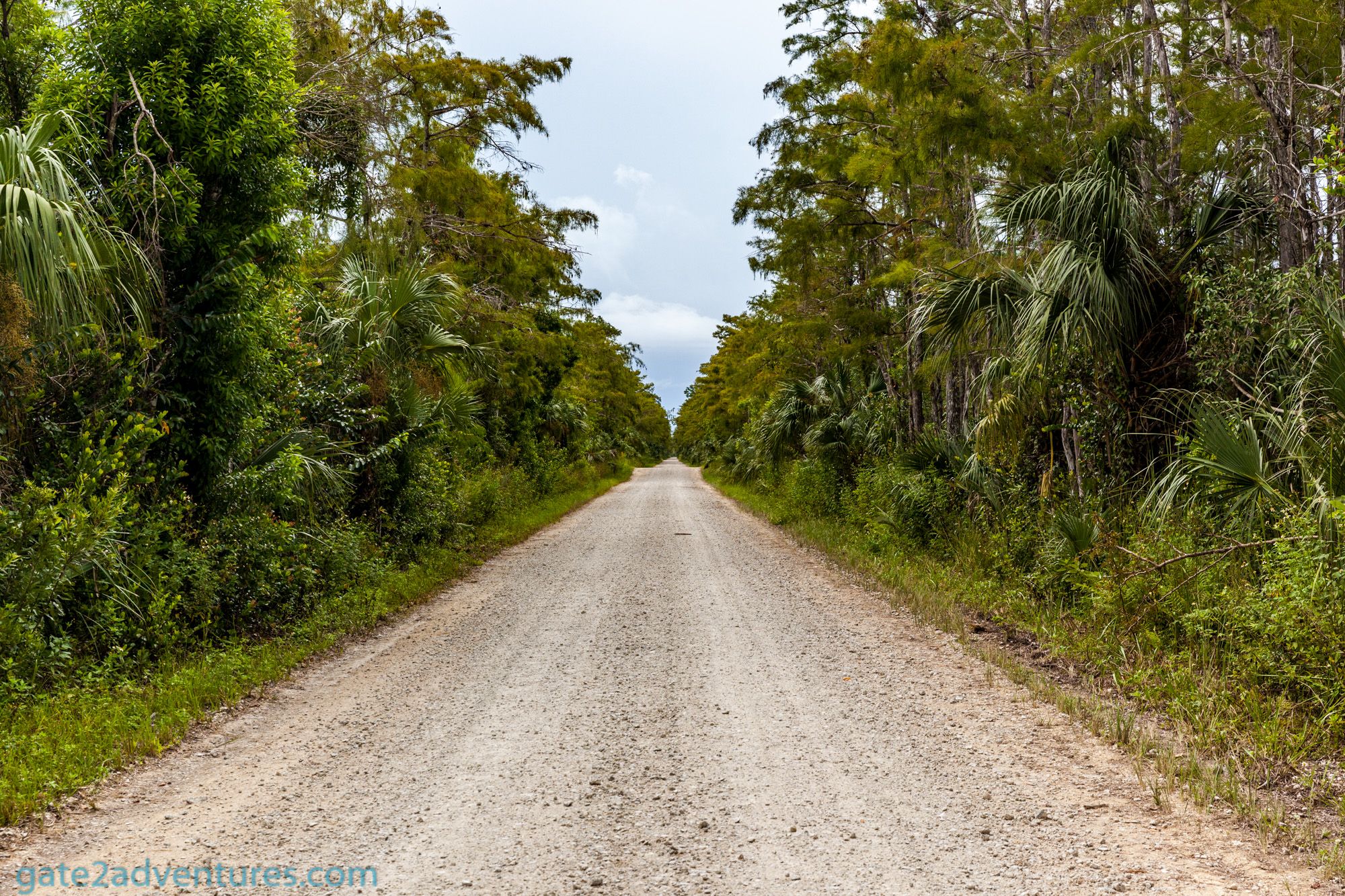
Along the way, you can choose to leave the main stretch of Highway 41 and take a scenic detour. However, either of the two mentioned detours below will by-pass some of the other attractions along the way. Check the map at the end of the post for more info. Alternatively, you can take the scenic detours and on your way back to Miami you can visit the rest of the spots. It all depends on when you visit, as some of the places might be closed.
Loop Road Scenic Drive
The 24-mile long Loop Road is a gravel road for most of the route. It was created out of a dispute over the official route of the Tamiami Trail. The scenic road, otherwise known as County Road 94, brings you through a dwarf cypress forest, pine forests, and deep strands.
While traveling East to West you will enter the Loop Road at “40-Mile Bend”, which is the first bend in the Tamiami Trail coming from the east. The road continues south of the Tamiami Trail and will end at Monroe Station, where you merge back on to the Tamiami Trail. Monroe station was built in 1925 and served as a waypoint for people crossing the Big Cypress Swamp. On May 11, 2000, it was added to the U.S. National Register of Historic Places. It got boarded up and abandoned in July 2007 and burned down on April 9, 2016, by a fire that was accidentally started by a photographer. Now it’s just an empty parking lot, which gets used by people to park and access the backcountry across the Tamiami Trail.
A few interesting stops along the way:
- Pinecrest Service Station
- Tree Snail Hammock Trail
- Southernmost Point of the Florida Trail
- Sweetwater Strand
Turner River, Wagonwheel, Birdon Roads Loop
This 17-mile loop will take you on a small detour through open prairies and popular wading bird feeding areas. This road is for the most part of the route gravel and starts at the H.P. Williams Roadside Park. The park features restrooms, a picnic area, and a boardwalk for safe wildlife viewing. Usually, you can see alligators from the boardwalk. From here you follow the Turner River north. Drive slow and keep your eyes open to see the wildlife along the way. Alligators tend to hide on the sides of the river.
At mile 7.1 turn left onto Upper Wagonwheel Road and follow it until it becomes Birdon Road shortly after mile marker 10. Just before you turn onto Upper Wagonwheel Road, you probably see some swamp buggies parked along the road. Besides airboats, this is another way to explore the Big Cypress National Preserve.
Guides
Download a guide for the scenic routes from the National Park Service.
Location

Peter has a passion for Traveling, Photography, and Geocaching. These are the best ingredients for amazing adventures all over the globe. “Traveling is fun, no matter if you stay in a luxury hotel or travel like a backpacker.” Peter shares his experiences on his Blog www.gatetoadventures.com
Some of Peter’s photos are published on corporate websites, in-flight magazines, travel guides, and much more.




